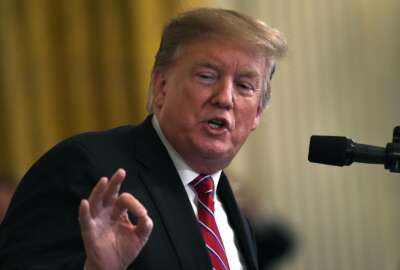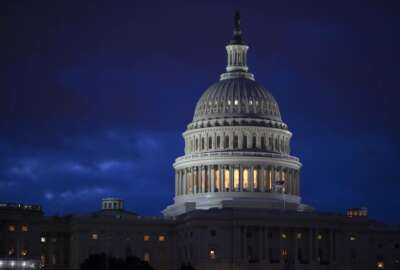
More paid leave for feds on the table, as COVID-19 reconciliation talks begin
One budget reconciliation proposal would create a brand new bank of paid leave, worth about $570 million, for federal employees to recover from COVID-19 and care...
It’s time for federal employees to start paying attention to the budget reconciliation process again.
House Democrats are still in the beginning stages of drafting and finalizing budget reconciliation provisions to advance the president’s COVID-19 relief package.
But one provision, which Democrats on the House Oversight and Reform Committee unveiled Tuesday night, would allow federal employees to take up to 600 hours, or 15 weeks, of paid leave for pandemic-related reasons.
Federal employees may remember the budget resolution and reconciliation process from recent years, when Congress considered making cuts to the federal retirement system to uncover savings or offset spending boosts.
Congress never made good on those federal retirement proposals, at least not in recent years.
And while past attempts at budget reconciliation have focused more so on making cuts, House and Senate Democrats are considering the process today as a way to pass President Joe Biden’s COVID-19 relief package through a simple Senate majority.
The budget reconciliation process can be long and complex. It starts with a budget resolution, essentially a blueprint that details Congress’ spending priorities for a given year.
The House and Senate passed a budget resolution for the remainder of fiscal 2021 last week. It included reconciliation instructions to an array of House committees, who will take the lead on drafting up their own provisions. These provisions provide funding for and advance many of Biden’s priorities as he presented them in his American Rescue Plan.
The provisions may ultimately form a larger reconciliation bill. The bill has a fairly easy shot of passage in the House, but it’s more complicated in a 50-50 Senate. The Senate could, in theory, pass a reconciliation bill with all Democratic votes, with Vice President Kamala Harris as the tiebreaker.
Still, there’s a lot left to finalize before any kind of reconciliation bill makes it through Congress. Here are a few notable reconciliation provisions, as they stand today, that are on the table:
New paid leave bank for federal employees
Notably for federal employees, the House Oversight and Reform Committee has a reconciliation provision that would create a brand new bank of paid leave during the pandemic.
Full-time federal employees would be able to receive up to 600 hours of paid leave to recover from COVID-19, quarantine or care for a sick family member or a child who is attending virtual school due to the pandemic.
Employees could also use the leave for the purposes of receiving a COVID-19 vaccine or recovering from any symptoms or conditions related to immunization.
It appears the leave would apply to most federal employees, including Postal Service workers and health care professionals at the Veterans Health Administration. But employees must first exhaust their own paid sick leave before tapping into this new bank of leave under the COVID-19 relief package.
The price tag is $570 million, according to the committee. Federal workers could tap into the emergency federal employee leave fund through the end of fiscal 2021.
The committee is scheduled to markup this provision, as well as another that would provide state and local governments with roughly $350 billion, on Friday.
More money for pandemic oversight
The oversight committee will also consider additional funding for pandemic oversight.
Under the proposal from committee Democrats, the Government Accountability Office would receive an extra $77 million, while the Pandemic Responsibility and Accountability Committee would add another $40 million.
Both organizations would have access to the fund through 2025, according to the provision language.
Billions for VA health care, modernization
The House Veterans Affairs Committee has its own list of reconciliation measures that it will consider this week.
One provision would provide VA with an additional $272 million, which House Democrats said would help the department alleviate the impacts of the pandemic on claims and appeals processing.
“This funding will be used to increase staff overtime, expand Veterans Benefits Administration funded scanning of service records from federal records facilities impacted by COVID-19, improve scheduling of hearings and enhance contact center functions,” a summary of the reconciliation provisions reads. “In addition, funding supports the Board of Veterans Appeals efforts to improve mail processing and add temporary staff, including intake specialists, attorneys, and staff to support telehearings.”
The number of pending disability claims at VA has ballooned during the pandemic, department officials have said.
Another provision would give VA an additional $100 million for supply chain modernization efforts. VA’s inspector general would receive an additional $10 million.
And the Veterans Health Administration would get nearly $13.5 billion, which House Democrats said will cover more expensive health care services for veterans as a result of delaying treatments during the pandemic.
The funding would also allow VA to sustain CARES Act staffing and service-level expansions for suicide prevention, homelessness programs and telehealth, according to the summary.
All told, the VA provisions cost some $17 billion.
House and Senate Republicans have expressed concern last week with the price tag, citing recent statements from VA officials that indicated the department had enough funding to last through the end of the current fiscal year.
Congress gave VA $19.6 billion last March through the CARES Act.
“Congress and VA have worked collaboratively on needed funding, flexibility and other tools veterans needed from the onset of the pandemic,” Mike Bost (R-Ill.) and Jerry Moran (R-Kan.), the ranking members of the House and Senate VA Committees, said in Feb. 4 letter to VA’s acting secretary at the time. “That is why the $17 billion request is so perplexing. Even more confusing is the effort to rush it through Congress without knowing any material facts relative to the unobligated emergency funds mentioned above, the disconnect the request has with previous statements made by VA officials last year and the fiscal year 2021 appropriation levels and policy authorizations already provided.”
The House VA Committee is scheduled to mark up these reconciliation provisions Thursday.
Copyright © 2025 Federal News Network. All rights reserved. This website is not intended for users located within the European Economic Area.
Nicole Ogrysko is a reporter for Federal News Network focusing on the federal workforce and federal pay and benefits.
Follow @nogryskoWFED





